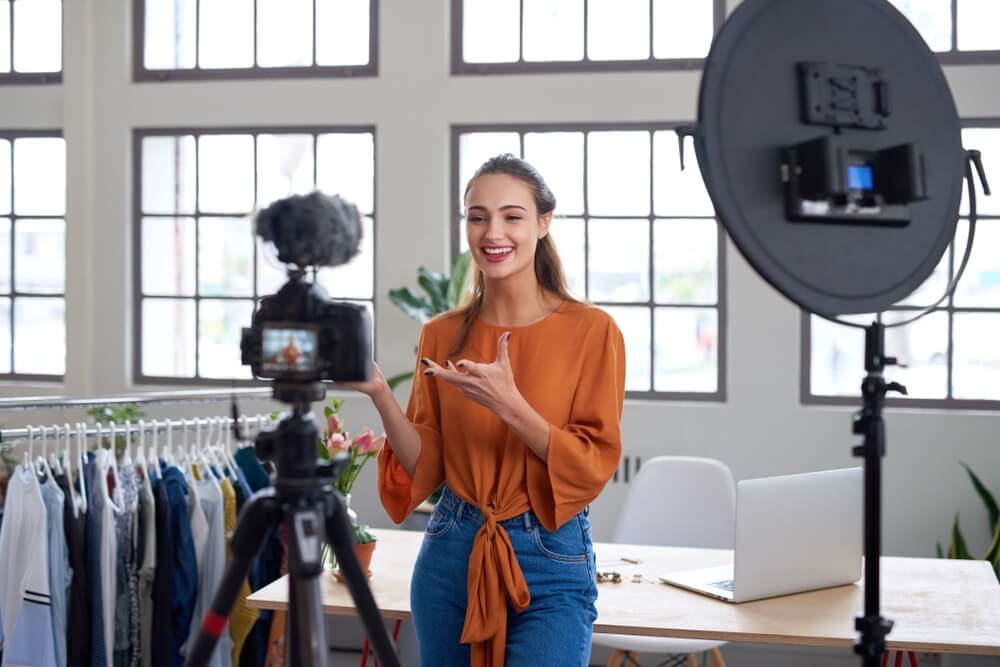
Self tapes, amirite? If you’ve had an audition since the turn of the decade, you know what I’m talking about and, most likely, you have an opinion about them. If you’ve been auditioning since the turn of the century (like me), then you know that self tapes have become a game changer in the casting world, for better or for worse. But no matter your feelings, these babies are here to stay, so let’s embrace this golden opportunity and put our best foot forward every time by creating the best self tape space we can.
It’s easy! Just open your garage, pour some concrete, insulate the walls, and buy a pristine and expensive backdrop, a top-of-the-line camera, a high-end lighting package and sound equipment that can not only pick up every subtle coo and breath you take but also the flapping of a butterfly’s wings three streets over. That should only cost you about $16,295.99, which is fine because once you book that first recurring character next week, it’ll pay for itself! Because the higher end your space is, the better your auditions will be, the more you’ll stand out and the quicker you’ll be recognized as the incredible talent you are, right? WRONG!
You are the only thing that you need to showcase your talent. That’s a fact. Okay, fine, for a self tape you need some time to record yourself, but you don’t need to buy a RED Digital Cinema V-Raptor XL 8K VV to do the job.
With that in mind, let’s discuss how you can create the best possible space for your actor self tapes that you can afford, using lots of material and equipment that’s already in your home, or maybe one degree away from you amongst the homes of your friends and family. Or, at the very least, cheap.
Let’s dive in!
Camera – The Best Option Is Probably in Your Pocket
Option 1: Let’s state the obvious right off the bat. The camera on your smartphone is probably the only camera that you’ll ever need. If all is in working order, you can move on to Option 2.
But, if your phone is getting old like mine is (the audio is shot, but that’s another topic for later!), it may be time for an upgrade. Since technology is moving faster than the speed of everything, most likely, your next upgrade will land you a phone that has a built-in camera that is better than any other camera you’ve ever owned. And now the way the new smartphone billing model works, your new phone will only cost you another few dollars a month. So, I would say look to this as your option number one.
Option 2: Get your hands on a stand-alone digital camera. This option could be for film nerds (again, like me), or techies, or maybe it’s for those of us who just don’t want to clog up our smartphone’s camera roll with all of our self tapes on top of the pictures of our vacations, kids and every meal they ate.
Having a dedicated camera just for self tapes can help keep your work/life entities more separated. I get it. Plus, having a dedicated camera that’s not on your phone means that you can keep it in the studio and ready to go at all times. And here’s the thing: you might already have a camera like this. Most digital cameras that have been manufactured since the mid-aughts have a video component. Some are better than others, so check out what you have first.
Also before you dish out the dough, ask around. Especially ask some older family members. Off the top of my head, I can think of at least two family members who have bought a really nice digital camera with a lens package in the past 5 years and who I have never seen use it after they got back from their cruise to Barbados. You know why they haven’t pulled it out again? See Option 1! The phone.
The phones have gotten so good and so convenient that it’s now almost unheard of for someone to take an expensive, bulky camera on a safari with them or to the park when their kids have a play date. So, this means that there are a plethora of really nice digital cameras just lying around, waiting for someone to find a use for them! And when you ask for it, just say you’d love to borrow it for a while and that you will return it as soon as they need it again (which will most likely be never).
Option 3: Okay fine, if you insist, you can buy a decent digital camera with the sole purpose of self tapes for a reasonable price. Here are two good ones: the Canon EOS Rebel T7 DSLR and the Sony ZV-1. A camera is not a bad investment. It just depends on your budget.
Ultimately, just find yourself a camera, whether it be on your phone or not, that is simple to use and captures a clear video of you.
Lighting – The Better to Help You Shine
I went to film school. Okay, fine, I was an acting major with a film minor, but I took enough film classes where I got to watch weird French films from the 1940s about people stealing bikes to know a thing or two about lighting. Or, at least, I should know a thing or two about lighting. But even when I do it “right” my lighting never looks as good as those old French guys used to do it. Anyway, what I’m saying is, don’t overthink your lighting setup—you don’t have to be an Oscar-winning cinematographer to book an under five—but don’t underthink it either.
Option 1: The sun! You have windows? The sun will give you all the light that you need. It’s what the sun is there for. It’s the sun’s raison d’être (French). So, use it when you can. Natural lighting can create a beautiful, unobtrusive softness to your self tape, and I’m sure it will be adequate lighting if it’s readily available to you.
Option 2: If you live in a cave (read: bottom floor studio apartment), or if the mere thought of the sun makes you sweat (that’s me!), maybe finding a dank corner for your setup is your best option, which would mean you’ll need some lights so you don’t end up accidentally turning in an awesome VO audition instead.
There are plenty of no-cost ways to light yourself, from floor lamps to desk lamps to overhead lamps. I’m talking lamps, lamps and more lamps. Lamps are handy, lamps are useful, and best of all, lamps already exist in your home. And with a strategically placed sheet or a backlit wall, you’d be surprised how effective this method can be.
Option 3: The buying of lights. My recommendation to you, hands down, is to go and get yourself a decent ring light. They aren’t expensive, and most of them come with a stand and a phone holder that goes in the middle of the light, so you get a light, a tripod and an adapter all in one! That’s totally worth the price. Plus a ring light gives you all the lighting you’d need in a convenient and transportable package, and it’s so easy to set up. I can’t recommend ring lights enough.
The next level up would be a lighting package. Lots of them only come with two lights, and if you’re a fellow film nerd, you’d know that you technically need three lights (the key, the fill and the backlight), so depending on how professionally lit you’d like your self tapes to be, this could get expensive and time-consuming. But you do you. Or in French: vous fait toi (I think).
Tripods and Adapters – Stability, the Actor’s Friend
Casting wants to see you. They don’t want to see your lighting, your camera technique or your backdrop. They want all of those things to be there, but they don’t want to see them. So give them a stable, well-lit shot of you. Stability is the key. You might laugh, but the number of tapes that I have seen where the reader is shakily holding the camera or the actor themself is holding the camera like a selfie, well let’s just say, it’s more than it should be. So how can you stabilize your shot?
Option 1: The best option here is to get yourself a ring light with a tripod and phone attachment (see above). Super easy, cheap and convenient. But if you already have access to a tripod (again, ask around), you can get an inexpensive adapter that will hold your smartphone. If you’re using a proper camera, it will most likely already be compatible with any tripod you have.
Backdrops – Your Behind Matters
Don’t just assume that no one cares about what’s behind you. The last thing you want to do is have a casting director read the titles of the books on your bookshelf while you’re acting your rear end off in the foreground. Think back to 2019 (if you can) to what casting rooms looked like (an empty room with a blank wall or curtain). A neutral background helps the actor POP. But different skin tones will pop better over different colors, so make sure you do some tests and find the right one for you.
Option 1: Always look at what you have at hand before you start thinking about spending money. My best backdrop at the beginning of the self tape revolution was just a blue sheet that I had in my garage that I would staple to a rafter. Done. I actually traveled with this sheet for a while and used it in hotel rooms across the country. And it worked great. But other free backdrop options are good, old-fashioned walls. Look around. Is there a wall that has a blank section or could easily be cleared of wall hangings? You really don’t need that much space.
Option 2: There are a lot of factors that go into where you shoot your self tapes, from roommates to loud neighbors to airflow, and I don’t know what your situation is, so I’ll just tell you what happened to me. First, I bought some gray paint and used it on a wall outside of my garage. It worked so great, but audio-wise, it was a nightmare. So a fellow actor offered up his sound-proofed garage to us both and we found a backdrop hanging system and bought some blue fabric.
I got lucky. Not everyone has a friend’s garage. If your space is limited, there’s always something like this pop-up backdrop that can be easily hung anywhere.
Audio – Some Sound Advice
Well, you have all of the equipment for your visual self tapes so you should be good. Sound shmound, you say, right? WRONG! As a filmmaker, I have seen countless short films and I’ll say this: a film could have the greatest cinematography, the best costumes, and the most amazing actors, but if the sound sucks, the film sucks. So, do not sleep on sound. You need your words to be captured clean and clear. So how do you do that?
Option 1: Your smartphone microphone might be more than fine. If you have a newer phone, most likely audio won’t be an issue. But, I have an iPhone XR and once, after shooting five takes, I discovered that my audio was cutting out. I had to switch to my reader’s phone on the fly. My point is, that you should be good, but always check the audio and make sure it’s fine before you do five takes on your self tape.
Option 2: If you haven’t yet decided on which device you will be shooting your self tapes, then I would do that before you buy a microphone because you will need to determine its compatibility. IPhones need different plugs and adapters than Galaxies or Nikon cameras, etc.
You’ll also need to choose from lavalier mics, shotgun mics and condenser mics, depending on how you feel your audio can best be captured. Here is a good tutorial.
Editing Your Best Takes
Option: There is only one affordable and effective option here, and that is to use what you’ve got. Every smartphone nowadays comes with a free editing app, or at least one that can be downloaded very cheaply. A self tape doesn’t have to be cut to death. You just need a program where you can string together the takes that you like, and maybe add a slate to the beginning or the end.
That’s it. Don’t overthink this. There’s nothing that Apple’s free app iMovie can’t do that you would need more expensive editing software like Adobe Premiere, Final Cut Pro or Avid. Unless you want more editing options, the free apps are all that you need. Here is a great tutorial for iMovie, but a quick search can garner videos for whichever software you choose.
Conclusion
Casting directors want to see you. I can’t stress that enough. Don’t worry about how good your self tape might look next to someone else’s self tape. I promise you if your self tape is clear and without any glaring distractions, you will be considered for the role as much as the next actor who may or may not have spent $11,000 on their at-home studio.
Be resourceful, and make the process as seamless and as inexpensive as you can. And remember, no matter what you are looking for—a reader, a camera, a mic—don’t hesitate to reach out to fellow actors, family and friends to see what’s available. Someone’s grandmother’s boyfriend’s unused tripod might be just sitting and waiting for a new adventure.
Oh, and congratulations! Let’s not bury the real lede! You are getting self tape auditions! That is the biggest hurdle you have to clear on your acting track. So, soak that in for a moment, then get to work on memorizing your lines and making strong choices for your audition. The rest, as they say, if you’ve gotten your self tape plan in order, will fall in line. And whatever will be, will be. (Or in French: Que sera sera … sorry.)
And now that you’ve learned how to perfect your self tape game, jump on to Casting Frontier to discover the roles that are just waiting to be filled by you!
You may also like:
- How to Build a DIY Voiceover Studio on a Budget
- Best Cameras for Self Tape Auditions
- The Five Items You Need In Your Self Tape Studio
Comments
Written by Jason Dugre




